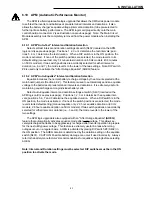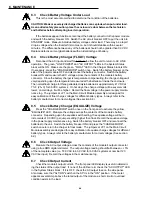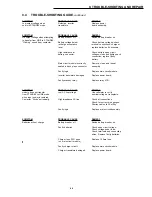
8.3
Check Battery Voltage Under Load
This is the most accurate method to determine the condition of the batteries.
CAUTION: Weak or severely discharged batteries can explode when put under load.
As an added safety precaution, place the enclosure's door between the technician
and batteries before attempting inverter operation.
If the batteries appear functional, reconnect the battery connector to the power module
and switch the battery breaker ON. Switch the AC circuit breaker OFF to put the unit into
STANDBY mode. Measure individual battery voltages under load. There may be a rapid
drop in voltage when the inverter first comes on, but it should stabilize within several
minutes. The difference between any of the batteries should not be greater than 0.3 VDC.
Replace defective or marginal batteries with an identical type of battery.
8.4
Check Battery Charger (FLOAT) Voltage
Reconnect the AC input and wait for 1 minute to allow the unit to return to AC LINE
operation. The green, "LINE POWER" and "AC OUTPUT" LEDs in the System Status
block will be ON. Make sure the green, "FLOAT" LED in the Charger Status block is ON.
If necessary, press the "CHARGE MODE" switch once. Switch the battery breaker on the
side of the power module OFF and disconnect the battery connector. Switch the battery
breaker ON and measure the DC voltage across the contacts of the module's battery
connector. Since the battery charger is temperature compensating, the charge voltage will
vary depending upon the temperature measured at the batteries or inside the enclosure.
The normal float charge for three gelled electrolyte batteries is approximately 41 VDC at
77
0
F (25
0
C) for 36 VDC systems. On hot days, the charge voltage will be several volts
lower; on cold days, it will be higher. Record the float voltage in the power supply mainte-
nance log. The jumpers at JP1 on the Main Circuit Module assembly are designed for
easy calibration of float charge voltages for different battery types. Always refer to the
battery manufacturer for correct voltages (See section 6.9).
8.5
Check Battery Charger (EQUALIZE) Voltage
Press the "CHARGE MODE" switch once on the front panel to activate the yellow,
"EQUALIZE" LED. Measure the voltage across the contacts of the module's battery
connector. Depending upon the equalize switch setting, the equalize voltage will be in
increments of 0.9 VDC (per jumper setting) higher than float. Record the equalize voltage
in the power supply maintenance log. Switch the battery breaker OFF and reconnect the
batteries to the unit. Switch the battery breaker ON and press the "CHARGE MODE"
switch once to return the charger to float mode. The jumpers at JP1 on the Main Circuit
Module assembly are designed for easy calibration of equalize charge voltages for different
battery types. Always refer to the battery manufacturer for correct voltages (See section
6.9).
8.6
Check Output Voltage
Measure the AC output voltage across the contacts of the module's output connector
using a true RMS digital voltmeter. The output voltage reading should fall b/- 5%
of the nameplate value (i.e. 57.0 VAC to 63.0 VAC for 60 VAC systems at nominal 120
VAC line input.) Record the voltages in the maintenance log.
8.7
Check Output Current
Check the module's output current. The front panel LED display is useful in determin-
ing the status of the output load. If none of the LEDs are lit, check the "AC OUTPUT" LED
in the System Status block. If it is OFF, check the AC output fuse on the side panel.
Also make sure that "ALT/ON" switch on the SPI is in the "ON" position. If the meter
appears several Amps above the rated output of the module, a short circuit or overload
condition exists in the load.
44
8. MAINTENANCE









































